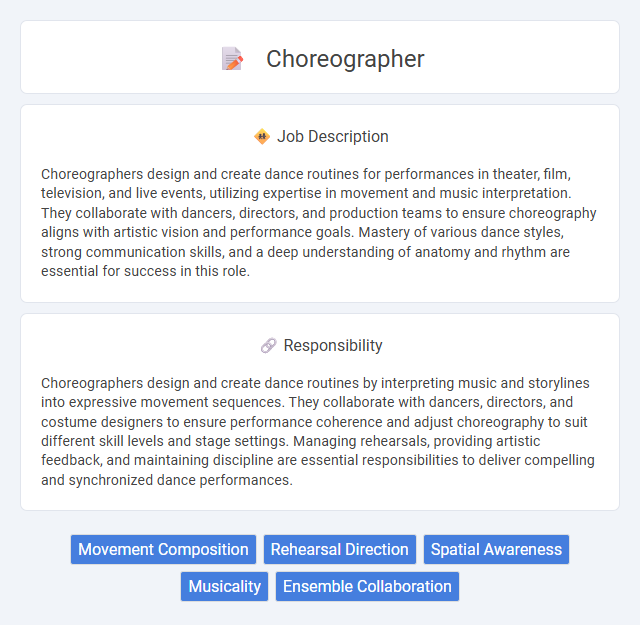
Choreographers design and create dance routines for performances in theater, film, television, and live events, utilizing expertise in movement and music interpretation. They collaborate with dancers, directors, and production teams to ensure choreography aligns with artistic vision and performance goals. Mastery of various dance styles, strong communication skills, and a deep understanding of anatomy and rhythm are essential for success in this role.
People with a strong sense of creativity, physical stamina, and excellent coordination are likely to thrive as choreographers. Those who enjoy working collaboratively and have patience for repetitive practice might find this career rewarding. Individuals who struggle with time management or prefer less physically demanding jobs may find this role less suitable.
Qualification
Choreographers typically require a formal education in dance, often holding a bachelor's degree in dance, performing arts, or a related field, complemented by extensive experience in various dance styles. Strong creativity, physical stamina, and an understanding of music and rhythm are essential qualifications. Proficiency in choreography software and the ability to collaborate with dancers, directors, and producers enhance job performance.
Responsibility
Choreographers design and create dance routines by interpreting music and storylines into expressive movement sequences. They collaborate with dancers, directors, and costume designers to ensure performance coherence and adjust choreography to suit different skill levels and stage settings. Managing rehearsals, providing artistic feedback, and maintaining discipline are essential responsibilities to deliver compelling and synchronized dance performances.
Benefit
A choreographer's job likely offers creative fulfillment through the opportunity to design and direct dance routines, fostering artistic expression. This role probably provides collaborative experiences with performers and production teams, enhancing teamwork skills. Financial benefits may vary, but successful choreographers might gain recognition that leads to higher-paying projects or teaching opportunities.
Challenge
Choreographers likely face the challenge of blending creativity with technical precision to design engaging dance routines that suit various performance styles and skill levels. Meeting tight deadlines and adapting to last-minute changes probably add pressure to their workflow, requiring strong problem-solving abilities. Navigating diverse client expectations while maintaining artistic vision may require continuous communication and flexibility.
Career Advancement
Choreographers advance their careers by building a strong portfolio of diverse projects that showcase creativity and technical skill. Gaining experience through collaborations with dance companies, theaters, and media productions enhances industry visibility and professional network. Pursuing specialized training and certifications in dance styles or choreography techniques further opens opportunities for leadership roles and high-profile commissions.
Key Terms
Movement Composition
Choreographers specialize in movement composition by designing and arranging dance sequences that convey emotions and narratives through physical expression. They integrate diverse styles, rhythms, and spatial patterns to create cohesive performances tailored to music, themes, and performers' abilities. Expertise in anatomy, kinesiology, and performance dynamics enhances their ability to craft innovative, impactful movement vocabulary.
Rehearsal Direction
Rehearsal direction in choreography involves guiding dancers through precise movement sequences to ensure synchronization and expressiveness aligned with the artistic vision. The choreographer analyzes each dancer's performance, offering detailed feedback and adjustments to refine timing, spacing, and emotional delivery. Mastery in rehearsal direction enhances the overall production quality, fostering a cohesive and impactful performance.
Spatial Awareness
Choreographers rely heavily on spatial awareness to design movement patterns that maximize the use of performance spaces and ensure fluid interactions among dancers. Mastery of spatial dynamics enables precise positioning, timing, and synchronization, enhancing the visual impact of routines. Advanced spatial cognition supports creative formations and transitions, crucial for engaging and innovative choreography.
Musicality
Choreographers create dance routines that emphasize musicality by closely interpreting rhythm, melody, and phrasing in their movements. Mastery of musicality allows choreographers to synchronize dancers' timing and express emotion in ways that enhance the overall performance. Understanding diverse musical genres and beats is essential for crafting dynamic and rhythmically engaging choreography.
Ensemble Collaboration
Choreographers excel in ensemble collaboration by coordinating dancers to achieve synchronized movement and expressive storytelling. They develop intricate formations, timing, and dynamics that enhance overall performance quality while fostering a cohesive team environment. Expertise in communication and adaptability ensures seamless integration of individual strengths into a unified artistic vision.
 kuljobs.com
kuljobs.com